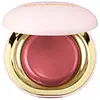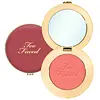What's inside
What's inside
 Key Ingredients
Key Ingredients

 Benefits
Benefits

 Concerns
Concerns

 Ingredients Side-by-side
Ingredients Side-by-side

Isodecyl Isononanoate
EmollientSilica
AbrasiveC12-15 Alkyl Benzoate
AntimicrobialIsodecyl Neopentanoate
EmollientOctyldodecyl Stearoyl Stearate
EmollientMethyl Methacrylate Crosspolymer
Limnanthes Alba Seed Oil
Skin ConditioningPolyethylene
AbrasiveSynthetic Fluorphlogopite
Dicalcium Phosphate
AbrasiveTocopheryl Acetate
AntioxidantPentaerythrityl Tetra-Di-T-Butyl Hydroxyhydrocinnamate
AntioxidantHelianthus Annuus Seed Oil
EmollientGardenia Florida Fruit Extract
Skin ConditioningNelumbo Nucifera Flower Extract
Skin ConditioningNymphaea Odorata Root Extract
RefreshingCI 45410
Cosmetic ColorantCI 77891
Cosmetic ColorantIron Oxides
CI 42090
Cosmetic ColorantCI 15850
Cosmetic ColorantCI 15985
Cosmetic ColorantIsodecyl Isononanoate, Silica, C12-15 Alkyl Benzoate, Isodecyl Neopentanoate, Octyldodecyl Stearoyl Stearate, Methyl Methacrylate Crosspolymer, Limnanthes Alba Seed Oil, Polyethylene, Synthetic Fluorphlogopite, Dicalcium Phosphate, Tocopheryl Acetate, Pentaerythrityl Tetra-Di-T-Butyl Hydroxyhydrocinnamate, Helianthus Annuus Seed Oil, Gardenia Florida Fruit Extract, Nelumbo Nucifera Flower Extract, Nymphaea Odorata Root Extract, CI 45410, CI 77891, Iron Oxides, CI 42090, CI 15850, CI 15985
Mica
Cosmetic ColorantAlumina
AbrasiveZinc Stearate
Cosmetic ColorantCaprylic/Capric Triglyceride
MaskingOctyldodecyl Stearoyl Stearate
EmollientMethylpropanediol
SolventCaprylyl Glycol
EmollientGlycerin
HumectantIris Florentina Root Extract
MaskingLeuconostoc/Radish Root Ferment Filtrate
AntimicrobialRetinyl Palmitate
Skin ConditioningPhenylpropanol
MaskingZinc Sulfate
AntimicrobialKaolin
AbrasiveParfum
MaskingCoumarin
PerfumingSodium Dehydroacetate
PreservativeCI 77891
Cosmetic ColorantCI 77491
Cosmetic ColorantCI 77492
Cosmetic ColorantCI 77499
Cosmetic ColorantCI 42090
Cosmetic ColorantCI 45410
Cosmetic ColorantCI 15850
Cosmetic ColorantCI 77007
Cosmetic ColorantCI 19140
Cosmetic ColorantMica, Alumina, Zinc Stearate, Caprylic/Capric Triglyceride, Octyldodecyl Stearoyl Stearate, Methylpropanediol, Caprylyl Glycol, Glycerin, Iris Florentina Root Extract, Leuconostoc/Radish Root Ferment Filtrate, Retinyl Palmitate, Phenylpropanol, Zinc Sulfate, Kaolin, Parfum, Coumarin, Sodium Dehydroacetate, CI 77891, CI 77491, CI 77492, CI 77499, CI 42090, CI 45410, CI 15850, CI 77007, CI 19140
 Reviews
Reviews

Ingredients Explained
These ingredients are found in both products.
Ingredients higher up in an ingredient list are typically present in a larger amount.
Ci 15850 is the pigment color red. It is an azo dye and created synthetically.
Azo dyes need to be thoroughly purified before use. This allows them to be more stable and longer-lasting.
This ingredient is common in foundations, lipsticks, and blushes. This color is described as brown/orangey red.
It has many secondary names such as Red 6 and Red 7. According to a manufacturer, Red 6 usually contains aluminum.
Learn more about CI 15850Ci 42090 is a synthetic dye created from petroleum. It is used to give a bright blue color to cosmetics, medicine, and food.
CI 45410 is a synthetic red-pigment and dye.
It often goes by both Red 28 or Red 27; manufacturers label both ingredients as CI 45410.
This dye is commonly found in makeup because it imparts a vivid color. Some types of this dye change color based on pH level and interaction with moisture:
Your skin has a natural pH of around 4.5 - 5.5.
According to the FDA, CI 45410 is not permitted for use in eye products.
Red 27 is a flourescein dye and commonly used as a fluorescent tracer in medicine.
Learn more about CI 45410Ci 77891 is a white pigment from Titanium dioxide. It is naturally found in minerals such as rutile and ilmenite.
It's main function is to add a white color to cosmetics. It can also be mixed with other colors to create different shades.
Ci 77891 is commonly found in sunscreens due to its ability to block UV rays.
Learn more about CI 77891Octyldodecyl Stearoyl Stearate is created from stearic acid.
It is an emollient and thickens the lipid (oil) portion of a product. Due to its emollient properties, it may not be fungal-acne safe.